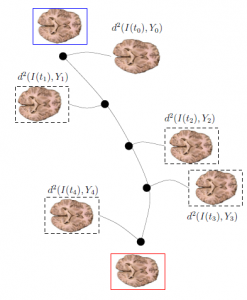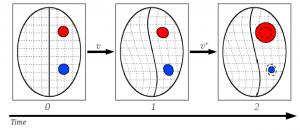Registration of Complex Data
We have developed a number of image registration methods with a particular focus on image time-series. We have developed (1) a method for the longitudinal atlas-building from diffusion tensor images [1], (2) a generalization of least-squares line fitting to the space of images (termed geodesic regression) which allows for compact representation of image-time series by their initial momenta and hence for simplified subsequent statistical analysis [2,3,4], and (3) have developed a registration method which can account for image appearance changes (as for example caused by a traumatic brain injury or a brain tumor) by jointly estimating a global space deformation and an overlaid geometric model change affecting image appearance [5].
A driving problem for the development of our methods has been brain imaging. However, our recent work has been motivated by the need of the pediatric airway group register airways. Airways show spatial variations on a variety of levels: (1) within-subject variation during the normal breathing cycle; (2) change within a subject over time; (3) change between subjects over time; (4) across-subject variation during the normal breathing cycle; (5) presence of pathology (e.g., stenosis) and articulated structures (such as the vocal fold and the epiglottis); and (6) variation in extracted information (for example for segmentation). Hence, the pediatric airway project is an ideal candidate to advance the state of the art in registration methods for temporal data for improved analysis for a clinically relevant problem.
Geodesic Regression for Image Time Series
 Registration of image-time series has so far been accomplished (1) by concatenating registrations between image pairs, (2) by solving a joint estimation problem resulting in piecewise geodesic paths between image pairs, (3) by kernel based local averaging or (4) by augmenting the joint estimation with additional temporal irregularity penalties. We proposed a generative model extending least squares linear regression to the space of images by using a second-order dynamic formulation for image registration [2]. Unlike previous approaches, the formulation allows for a compact representation of an approximation to the full spatio-temporal trajectory through its initial values. The method also opens up possibilities to design image-based approximation algorithms. The resulting optimization problem is solved using an adjoint method. Key to the formulation is to be able to write the image registration problem in initial value form. In the scalar-valued case (for linear regression) this amount to recasting the least square estimation for the line model y=mx+c into the second order dynamical system form d^2/dt^2 y = 0, y(0)=c, dy/dt(0)=c, where the initial conditions are simply the y-intercept and the slope. For the image-case we have an initial image and its initial momentum. In the optimization all images along the geodesic exert forces, which influence the initial condition for the geodesic. In the scalar-valued case this amounts to having a least squares solution, which can be interpreted as a physical system under force and momentum balance. We have also developed an approximate variant of this algorithm, which greatly simplifies the computation [3]. Furthermore, we have proposed a related approach which jointly captures spatial deformations and changes in image intensity within a regression framework [4]. The most exciting part about the overall solution approach is that it can be extended to general manifold data, which we will exploit in our future work on pediatric airways.
Registration of image-time series has so far been accomplished (1) by concatenating registrations between image pairs, (2) by solving a joint estimation problem resulting in piecewise geodesic paths between image pairs, (3) by kernel based local averaging or (4) by augmenting the joint estimation with additional temporal irregularity penalties. We proposed a generative model extending least squares linear regression to the space of images by using a second-order dynamic formulation for image registration [2]. Unlike previous approaches, the formulation allows for a compact representation of an approximation to the full spatio-temporal trajectory through its initial values. The method also opens up possibilities to design image-based approximation algorithms. The resulting optimization problem is solved using an adjoint method. Key to the formulation is to be able to write the image registration problem in initial value form. In the scalar-valued case (for linear regression) this amount to recasting the least square estimation for the line model y=mx+c into the second order dynamical system form d^2/dt^2 y = 0, y(0)=c, dy/dt(0)=c, where the initial conditions are simply the y-intercept and the slope. For the image-case we have an initial image and its initial momentum. In the optimization all images along the geodesic exert forces, which influence the initial condition for the geodesic. In the scalar-valued case this amounts to having a least squares solution, which can be interpreted as a physical system under force and momentum balance. We have also developed an approximate variant of this algorithm, which greatly simplifies the computation [3]. Furthermore, we have proposed a related approach which jointly captures spatial deformations and changes in image intensity within a regression framework [4]. The most exciting part about the overall solution approach is that it can be extended to general manifold data, which we will exploit in our future work on pediatric airways.
Geometric Metamorphosis

Standard image registration methods do not account for changes in image appearance. Hence, metamorphosis approaches have been developed which jointly estimate a space deformation and a change in image appearance to construct a spatio-temporal trajectory smoothly transforming a source to a target image. For standard metamorphosis, geometric changes are not explicitly modeled. We proposed a geometric metamorphosis formulation [5], which explains changes in image appearance by a global deformation, a deformation of a geometric model, and an image composition model. This work is motivated by the clinical challenge of predicting the long-term effects of traumatic brain injuries based on time-series images. This work is also applicable to the quantification of tumor progression (e.g., estimating its infiltrating and displacing components) and predicting chronic blood perfusion changes after stroke.
References:
[1] G. Hart, Y. Shi, M. Sanchez, M. Styner, and M. Niethammer, “DTI Longitudinal Atlas Construction as an Average of Growth Models,” MICCAI International Workshop on Spatio-Temporal Image Analysis for Longitudinal and Time-Series Data, 2010. [2] M. Niethammer, Y. Huang, and F.-X. Vialard, “Geodesic regression for image time-series,” in MICCAI 2011. [3] Y. Hong, M. Sanchez, M. Styner, and M. Niethammer, “Simple Geodesic Regression for Image Time-Series,” Workshop on Biomedical Image Registration (WBIR), 2012. [4] Y. Hong, S. Joshi, M. Sanchez, M. Styner, and M. Niethammer, “Metamorphic Geodesic Regression,” Proceedings of the International Conference on Medical Image Computing and Computer Assisted Intervention (MICCAI), 2012. [5] M. Niethammer, G. Hart, D. Pace, P. M. Vespa, A. Irimia, J. D. Van Horn, S. Aylward, “Geometric Metamorphosis,” in Medical Image Computing and Computer-Assisted Intervention (MICCA), 2011, pp. 639-646.